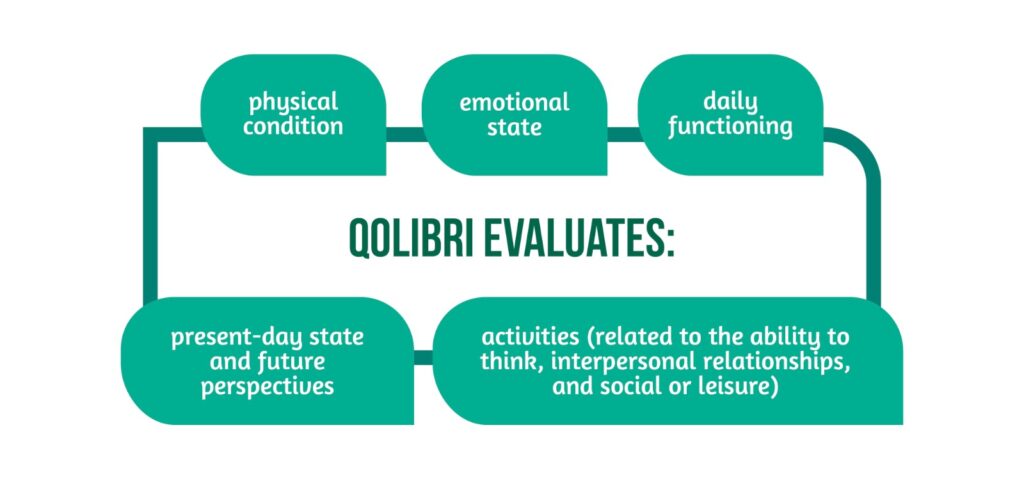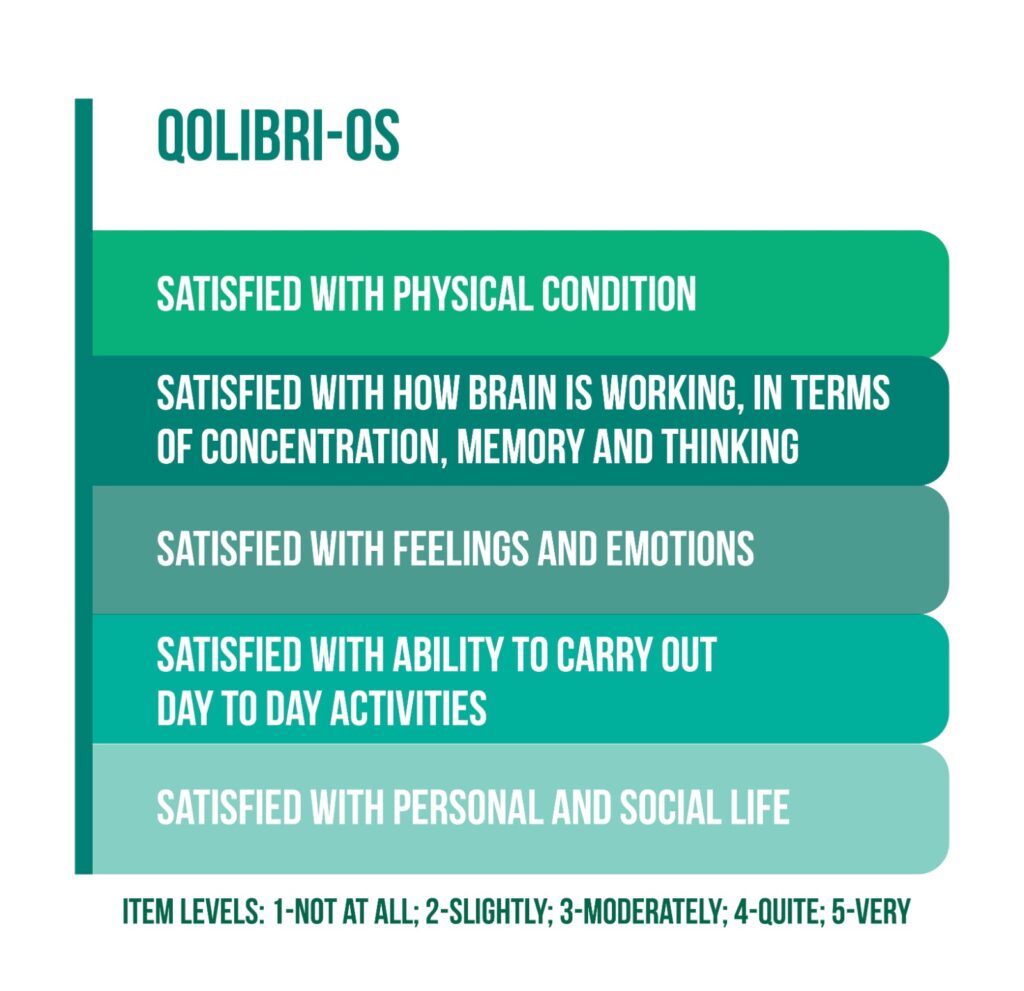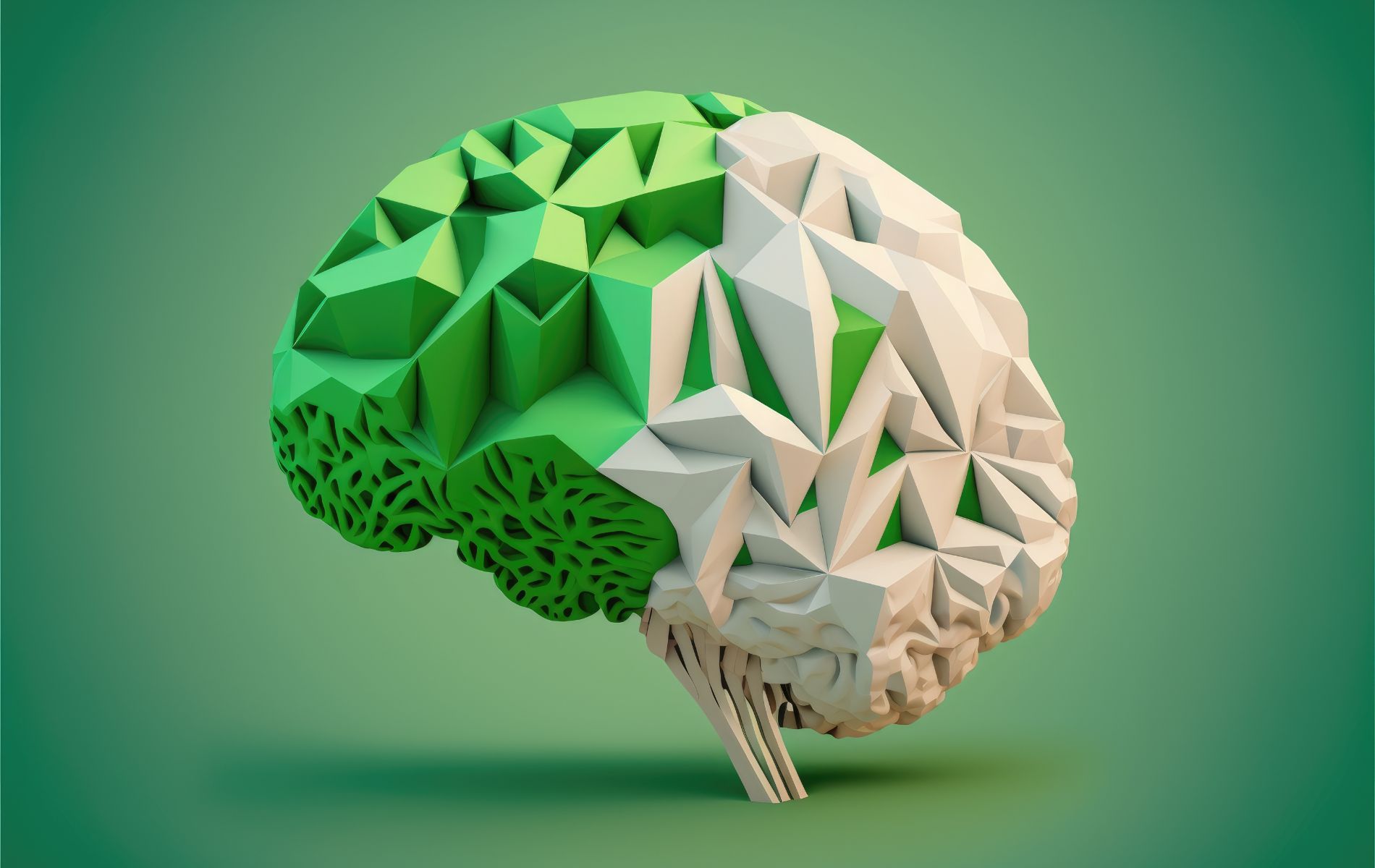Keywords: quality of life, traumatic brain injury, assessment tool, QOLIBRI, QOLIBRI-OS, health-related quality of life
Introduction
Traumatic brain injury (TBI), in its complexity, has a critical societal impact due to the increased mortality and disability of TBI patients and the influence on those around them [1].
Post-TBI disability ranges from:
- physical
- emotional
- behavioral
- cognitive.
The various outcomes post-TBI encompassing physical, psychological, cognitive, and emotional states have been documented. Moreover, research has also focused on the quality of life after TBI as an outcome [2–4]. Consequently, post-TBI, there is a significant change in the quality of life (QoL) of those directly or indirectly affected, with significant interpersonal differences regarding the coping mechanisms as well as self-perception and worth [4].
Several outcome assessments are used to show different elements mirroring the QoL of patients while evaluating physical, mental, and emotional health states and several activities:
- Extended Glasgow Outcome Scale (GOSE)
- Hospital Anxiety and Depression Scale (HADS)
- Satisfaction with Life Scale (SWLS)
- Visual Analogue Scale – Quality of Life (QoL-VAS)
- 36-Item Short Form Survey (SF-36) [1–5].
The impact of TBI on society is also mirrored on an economic level. TBI is a burden due to healthcare costs for all stakeholders (governments, policymakers, and healthcare capital providers) [1]. Therefore, there is a need for an assessment of the financial needs of patients to prioritize resources. Preference-based measures (PBMs) are needed and used for financial analysis. Unfortunately, most of the existing general PBMs lack precision regarding the heterogeneity of TBI patients’ specific outcomes, leading to an inaccurate estimation of financial burden.
QOLIBRI-overall scale (QOLIBRI-OS) is a TBI-specific straightforward method of health-related quality of life (HRQoL) evaluation, with wide usage since its development in 2012. Because it is not PBM-based, Voormolen et al. created a value set from the QOLIBRI-OS used to quantify the well-being of TBI patients and further offer a disease-specific PBM-based questionnaire useful for health state measurements of the population, economic evaluations, and stakeholders’ information [1].
The World Health Organization (WHO) defines the QoL as “an individual’s perception of their position in life in the context of the culture and value systems in which they live and in relation to their goals, expectations, standards, and concerns”, referring mainly to the activities and social abilities of people [3] (Figure 1).

Overall, the general aim of healthcare is to ensure a good QoL of patients with different illnesses. Correspondingly, for TBI patients, the objective of all healthcare interventions is represented by, ideally, a return to total health or a good healthcare state.
To achieve a more precise patient-oriented view regarding QoL, health-related quality of life (HRQoL) was defined as the patient’s subjective perspective on the consequences of well-being, health, and ability to complete different tasks. Several patient self-assessing areas were covered: physical, cognitive, social, and emotional, as well as daily living. Nevertheless, another observing person (family or healthcare professional) did the QoL assessment in patients with a significant cognitive post-TBI disability [4].
So far, the assessed consequences of TBI have covered mainly post-TBI functional abilities, ranging from the level of recovery of disabilities to psychological and social activity as well as state of health, leaving out the subjective patient-reported impact [4]. Furthermore, compared to disease-oriented QoL assessments, general ratings regarding patients’ health status are considered to lack focus and precision. Despite that, some of these assessment methods, like the Sickness Impact Profile, SF-36 Health Survey, or Satisfaction with Life Scale, have been widely used, offering comparative information on distinctive groups. Furthermore, tools with increased precision and insight into QoL disorder-related HRQoL have been developed [4].
Assessment of the Quality of Life after TBI: QOLIBRI
HRQoL is considered to be an essential outcome for TBI patients. Therefore, the QOLIBRI Task Force, an international group of professionals from different backgrounds thus conferring multidisciplinarity (neurosurgeons, neurologists, psychologists, etc.), developed a TBI-oriented tool for the assessment of the quality of life of TBI patients named QOLIBRI (Quality of Life after Brain Injury instrument in TBI).
The questionnaire is the product of an extensive review of the existing literature regarding TBI and multiple consensus assemblies. Additionally, the multitude of dimensions of TBI was considered, ranging from cognition, self-worth, perception of itself, self-regard, and the level of adaptation to the new state of health and life conditions. Another salient point was the attention given to the tool’s validity, considering the impact of the significant, if not critical, differences between patients concerning various fields like cognition, daily activities, or self-regard. Moreover, the questionnaire’s validity and psychometric value were assessed with emphasis on cognition-related disabilities, but not exclusively. Another significant aspect was the development of the questionnaire in a total of six languages.
Structure of QOLIBRI
The assessment of multiple tools by members of the task force led to a first thorough selection of 56 items. Following the first validation study on over 1500 TBI patients from several countries, 49 items comprised the first validated version. The items covered are showcased in Figure 2.

The items were formulated as satisfactory or bothersome statements assessed using a 5-point scale. The tool also included some open questions to highlight the relevance of the statements for the participants.
Furthermore, the questionnaire was translated into several languages, and a validation study was followed to ensure further verification and assessment of the final clinical settings. Forty-three items were categorized into 7 domains, while the other six comprised a separate scale, namely the QOLIBRI-OS. The extensive analysis led to the final version of QOLIBRI consisting of 37 items categorized into 4 fulfillment scales covering “cognition”, “self”, “daily life and autonomy”, “social relationships”, and two scales covering “emotions” and “Physical problems”. The calculated scores led to values ranging from 0 to 100, the first representing the lowest possible QoL and the latter the best.
The study by Nicole von Steinbuechel et al. showed that QOLIBRI could confer fine psychometric attributes as well as identify TBI-related HRQoL more extensively compared to GOSE and SF-36 (SF-36, for example, does not approach the concepts of “self” or “cognition”), thus revealing important information about the patient’s outcome after TBI [4,5].
QOLIBRI-OS – a brief instrument for QoL evaluation in TBI patients
QOLIBRI has shown that it can provide a detailed image of HRQoL for TBI patients, but a brief overall score can be used for a global evaluation. Shortness and simplicity can lead to an increase in compliance in patients who on the one hand, might not have enough patience and, on the other hand, might have cognitive disabilities that could interfere with the completion of a more complex questionnaire.
Concomitantly, single-item QoL assessment proved unreliable, with multiple-item assessments showing better psychometric properties. Additionally, one of the widely used questionnaires, the Satisfaction with Life Scale (SWLS), with good psychometric properties, evaluates the quality of life in a more general manner but lacks specific TBI-related questions. This has led to the development of a TBI-specific HRQoL evaluation method, namely the QOLIBRI-OS, developed simultaneously with the QOLIBRI intending to provide an overview of several elements concerning the HRQoL [1,4,5].
QOLIBRI-OS is a short scale encompassing six items evaluating patients’ satisfaction regarding diverse aspects influencing life, ranging from physical, cognitive, and emotional states to personal, social, and overall daily functional abilities. Patients must choose the level of satisfaction on a 5-point scale for each of these items. Furthermore, it also evaluates the patient’s present situation and outlook.
The 2012 study by Steinbuechel et al. showed the validity of QOLIBRI regarding post-TBI disability supported by the solid connection of outcomes with GOSE. Moreover, the comparison with the SF-36 revealed that QOLIBRI had covered extended areas and that although some assessed elements regarding QoL were different, the physical and mental health components were strongly correlated, thus indicating their significance regarding QoL.
Overall, this study illustrated that QOLIBRI-OS had satisfactory psychometric characteristics with a strong correlation with GOSE as a method of outcome evaluation in comparison to other brief assessments of the patient’s welfare. Moreover, there was a high correlation between QOLIBRI and QOLIBRI-OS. Although QOLIBRI is a more comprehensive tool in assessing the HRQoL of TBI patients, QOLIBRI-OS can be used instead, especially when a minimal intervention is needed but also to capture areas lacking in other scales regarding self and cognition [5].
Quantifying health states using a value set from QOLIBRI-OS
The existing general HRQoL PBM-based questionnaires (e.g., EQ-5D or health utility index 2) do not cover TBI-specific aspects as opposed to the non-PBM-based QOLIBRI-OS. Therefore, transforming QOLIBRI-OS using preference weights for all health states results in utility scores that can enable several applications:
- Possibility of financial analysis
- Measures of health in TBI patients, including quality-adjusted life years (QALYs)
- Comparison of HRQoL between patient groups (including different diseases)
- Precision in the assessment of the impact of TBI outcomes
- Precision in the evaluation of the benefit of aid for patients
- Evaluation of the preferences regarding the general population’s health states.
Creating value sets derived from QOLIBRI-OS gives weight to each of its items. This allows the calculation of QALYs, but for this purpose, the values need to be between 0 and 1, representing death, and, respectively, a healthy state. The lower the utility score, the higher the effect on HRQoL. Consequently, each health state will have a summary index value with a determined value set. Two preference-elicitation methodologies were used for value attachment to health states: discrete choice experiments (DCEs) and visual analog scale (VAS). Both methods are used for counting health outcomes. VAS quantifies the patient’s perspective on a hypothetical state of well-being using a score from 1-100 (1 meaning worst health state and 100 best health state).
In contrast, DCE can predict values using stated preferences for hypothetical situations that cannot be assessed in real life. For the development of the value set, two personal items (present condition and future expectations) have been removed from QOLIBRI-OS in order not to hinder its use in other diseases. Consequently, the questionnaire had five items with 5-point satisfaction answers, as shown in Figure 3.

A three-step methodology was used, as shown in Figure 1. First, the health states for valuation were selected because of too many possible well-being states. Three hundred ninety-two were selected for DCE, mirroring the severity of TBI, mortality, and the extremes of health states (best and worst) for VAS. This step was followed by evaluating and ranking the health states according to the feedback received regarding the QoL from responders for each health state, thus creating health values reflecting the preference for the health states.
The study population consisted of over 13,500 respondents from the general population of the Netherlands, Italy, and the United Kingdom). The questionnaire is made available in all three languages consisting of sixteen DCE and three VAS questions and demographic data (sex, level of education, and income). The DCE used for the valuation of health states consisted of paired health states, as seen in Figure 2, from which participants had to choose the preferred one, regardless of duration. The main idea of the DCE is mirrored in the choices between different health states that are guided by differences regarding the levels of the elements that define health states. By using combinations and modified levels of severity of health states, an estimation of the significance of preferences was possible.
Additionally, a color-coded severity level was used for elements: green-very satisfied to red-not at all satisfied. Next, the VAS was rescaled with valuations ranging from 0 to 1, the first reflecting death and the latter reflecting the best health state. The final step was the statistical modeling with which the values for all health states were created and, consequently, the utility score of QOLIBRI-OS.
The scores were generated using DCE replies anchored to VAS replies. A 20-variable model resulted for QOLIBRI-OS (four levels x five dimensions) that allowed differences between coefficients, dimensions, and levels of disabilities. The responses were graded as 1- “very satisfied” to 5-“not at all satisfied”, thus defining the worst health state as 5 and the best health state as 1 for each of the five items. Following the statistical analysis, the median age of respondents was 45 years, with almost half employed and 15% retired. Additionally, 50% had experience with serious illness personally or in the family. The DCE revealed a preference for health state A mirrored in the lower sum scores, while the VAS showed an increase in the utility score with a decrease in sum scores.
Regarding value sets, for all study populations, the lowest estimation was encountered for emotional states and the highest for the cognitive state. It is worth mentioning that in the UK, specifically, the lowest estimation was for social and personal life and the highest for the cognitive state. The weight increased for the items between levels four and five, showing the difference between minor and no satisfaction. In this study, utility scores for QOLIBRI-OS were created, thus allowing its application to measure population health, do economic evaluations, and offer information to TBI stakeholders [5].
Conclusion
The impact of TBI directly on the affected patient and indirectly on society due to secondary disabilities has been carefully studied. The broad definition of the QoL has led to the introduction of HRQoL to enhance precision. Additionally, if the majority of HRQoL assessment tools are general, QOLIBRI and QOLIBRI-OS offer a disease-oriented tool for evaluating QoL.
QOLIBRI is a comprehensive tool, while QOLIBRI-OS is a brief one with good psychometric properties and comparable results. The development of utility scores for QOLIBRI-OS allows further evaluation of the TBI population`s health state and financial burden, thus offering information to TBI stakeholders. [1–5].
For more information about the impact of TBI visit:
- Can TBI affect taste and smell?
- The importance of prehospital care for severe TBI
- Mild TBI outcomes – lesssons from the CENTER-TBI study
We kindly invite you to browse our Interview category https://brain-amn.org/category/interviews/. You will surely find a cluster of informative discussions with different specialists in the field of neurotrauma.
References
- Voormolen DC, Polinder S, von Steinbuechel N, Feng Y, et al. Health-related quality of life after traumatic brain injury: deriving value sets for the QOLIBRI-OS for Italy, The Netherlands and The United Kingdom. Quality of life research: an international journal of quality of life aspects of treatment, care and rehabilitation 2020; 29(11), 3095–3107. doi: 10.1007/s11136-020-02583-6
- Sukraeny N, Songwathana P, & Sae-Sia W. Quality of Life (QoL) in patients with Traumatic Brain Injury (TBI): A Literature Review. Nurse Media Journal of Nursing 2013; 3(2), 607 – 619. doi: 10.14710/nmjn.v3i2.6002
- World Health Organization. 2022. WHOQOL: Measuring Quality of Life; Available here
- Von Steinbüchel N, Wilson L, Gibbons H, Hawthorne G, et al. Quality of Life after Brain Injury (QOLIBRI): scale development and metric properties. Journal of neurotrauma 2010, 27(7), 1167–1185. doi: 10.1089/neu.2009.1076
- Von Steinbuechel N, Wilson L, Gibbons H, Muehlan H, Schmidt, et al. QOLIBRI Overall Scale: a brief index of health-related quality of life after traumatic brain injury. Journal of Neurology, Neurosurgery & Psychiatry, 2013, 83(11), 1041–1047. doi:10.1136/jnnp-2012-302361




